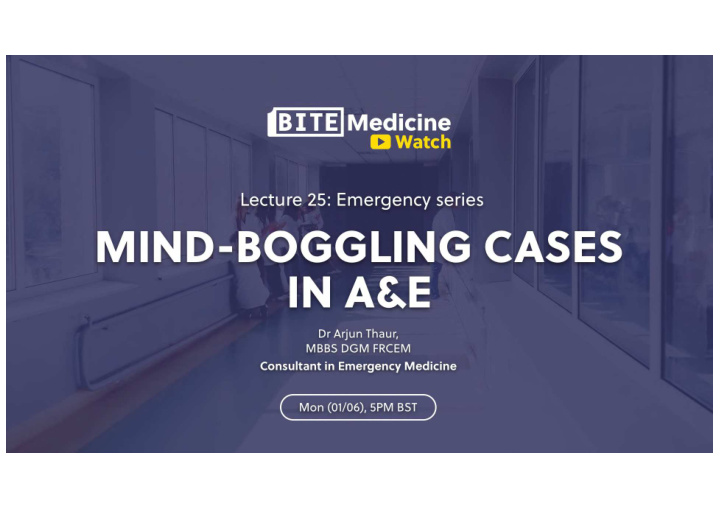



Today’s guest speaker 2
Case 1 History A 19-year old male is dropped off at the ambulance ramp outside the emergency department actively bleeding. He is brought into the resuscitation room on a trolley. He has rapid shallow breathing and is semi- conscious. Initial observations HR 140, BP non-recordable, RR 40 ABCDE assessment : stab wound anterior to the chest Our next steps Adult Trauma team activated • Major Haemorrhage Protocol activated • 3
What happened next… • Cardiac arrest – ALS algorithm initiated • Anaesthetic Registrar intubated the patient • Cardiothoracic Registrar in attendance • Decision to perform emergency thoracotomy • ‘O’ neg blood transfused along with fresh frozen plasma and platelets. • Clam shell thoracotomy done • Internal defibrillation performed along with internal cardiac massage • Descending Thoracic Aorta clamped 4
What happened next… 5
Emergency thoracotomy Indications? Types? 6
Clamshell thoracotomy 7
Left anterolateral thoracotomy 8
Case 2 History A 22 year-old male is brought to the emergency department by ambulance. He was found in a night club semi-conscious, hot and sweaty. ABCDE assessment GCS E1 V1 M4: increased muscle tone and rigidity Pupils bilaterally 5+ Observations HR 130, BP 180/120, RR 8, Temp 40 VBG results pH 7.0 (7.35-7.45) Our next steps HCO3 (mmol/L) 8 (23-29) Decision to intubate to protect airway K (mmol/L) 8.1 (3.5-5.2) 9
What happened next… • Active cooling methods initiated • Treatment of hyperkalaemia- calcium gluconate and insulin/dextrose • Urinary catheterisation and NG tube inserted • Cyproheptadine 12mg and sodium bicarbonate given • Vascath inserted for urgent haemodialysis • Patient transferred to critical care 10
Drug Drug-induc induced d hy hyperpyrexia • Drugs? • Serotonin syndrome? 11
Management • Removal of precipitating drugs • Provision of supportive care • Control of agitation – diazepam • The administration of 5HT antagonists – cyproheptadine • Control of autonomic instability • Control of hyperthermia 12
Recap • Basics of emergency thoracotomy • Importance of ABCDE assessment • Drug-induced hyperpyrexia 13
Further reading • www.RCEMlearning.co.uk • www.LITFL.com • www.toxbase.org • ATLS – www.rcseng.ac.uk 14
References 1. Own work by DiverDave (talk) (Transfered by PhilippN/Original uploaded by DiverDave) / CC BY (https://creativecommons.org/licenses/by/3.0) 2. Cothren and Moore; licensee BioMed Central Ltd. / CC BY (https://creativecommons.org/licenses/by/2.0) 3. Saltanat ebli / CC0 4. Mikael Häggström / Public domain 5. Tonyliepert / CC BY-SA (https://creativecommons.org/licenses/by-sa/3.0) 6. James Heilman, MD / CC BY-SA (https://creativecommons.org/licenses/by-sa/4.0) 7. Saltanat ebli / CC0 8. Cancer Research UK / CC BY-SA (https://creativecommons.org/licenses/by-sa/4.0) 9. Stefan Bellini / CC0 15
Further information WE WILL INSERT A QR CODE You will now receive a Certificate of Attendance for HERE FOR CERTIFICATES / attendance at each webinar! Simply fill out the feedback form. FEEDBACK Want to get involved? Contact us at opportunities@bitemedicine.com to receive your information pack. Presenter’s contact details Stay up-to-date! Website : • Website : www.bitemedicine.com • Facebook : • Facebook : www.facebook.com/biteemedicine • Instagram : • Instagram : @bitemedicine • Email : • Email : admin@bitemedicine.com • 16
Recommend
More recommend